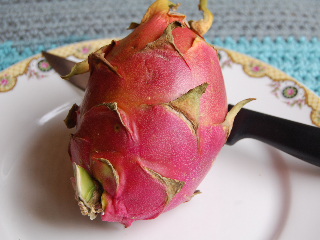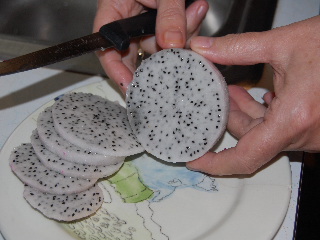
Amazing how many choices there are now in the produce section of our grocery stores! New and exotic things--like “dragon fruit”!! Yep, that’s what they call it. We saw it, so we bought it.
After just a little bit of research to find out just what the heck this stuff is and how you consume it, we thought we’d share some information with you.
First of all, the name. It is said to be called dragon fruit, because of its reddish colored skin which is covered with green scale-like protrusions that resemble the scales on a dragon’s exterior.
In reality, the plant that produces dragon fruit is in the Cactacea family. So the little spikey protrusions are believable as we imagine these to be the blossoms and fruit of cactus plants.
Dragon fruit is grown in tropical and subtropical climates such as Central America or the southern and western areas of the United States, as the plants are not cold hardy.
The plant is also popular in VietNam where the fruit has culinary uses in the local diet.
The dragon fruit we purchased and consumed was one with the classic red exterior with green spikes, and white interior. There are other varieties, one being yellow on the outside with white interior, and another being red on the outside with dark red flesh.

It’s easy enough to peel the dragon fruit, by first cutting the fruit in half and then peeling off the skin, which usually comes off in a single motion.
The interior consumable flesh is similar in texture, appearance, and taste to a kiwi. The main difference being that the dragon fruit is of white coloration with little black edible seeds, while the pulp of the kiwi has a green color but also with small edible black seeds.
The dragon fruit can be eaten by itself as a fruity snack, or it can be worked into smoothies or chopped and added into salads.
A serving of dragon fruit is low in calories but high in fiber as well as several other nutrients and vitamins.
The Vitamin C and carotenoids provide valuable antioxidants to the body, and can help boost the immune system. Dragon fruit is also a good source of magnesium and iron.
Next time you stroll through the produce section, see if your grocer offers dragon fruit. If they do, try one of these exotic and tasty fruits.